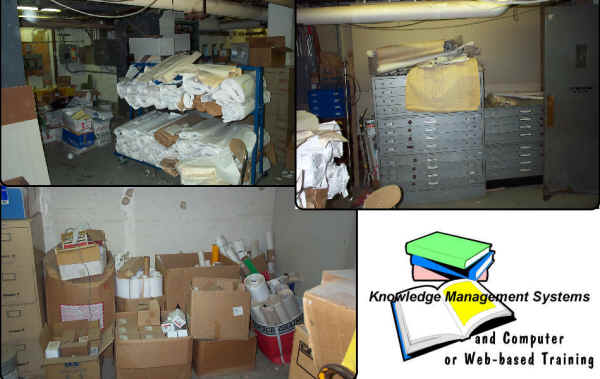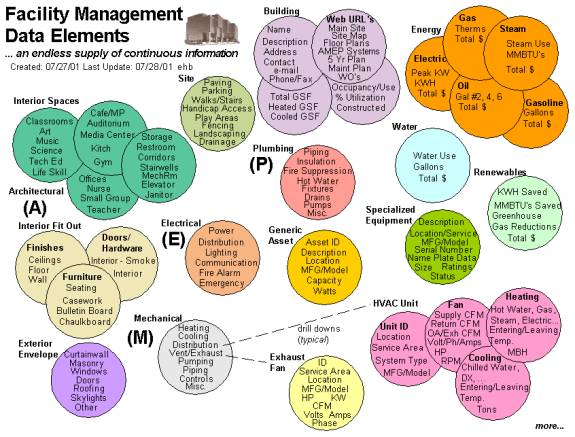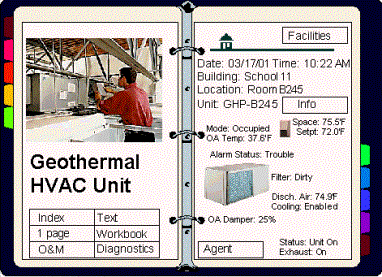
AutomatedBuildings.com
|
[an error occurred while processing this directive] |

Edward H. Brzezowski,
P.E.
Facility Energy Services, Inc.
Data has changed from a "hard copy" medium that was discarded on a periodic basis to create office or storage space to a digital medium waiting to be used in creative and useful ways. SQL servers and databases are becoming the roll-top desk of the 21st century.
Background:
Building operators, mechanics, and design professionals have traditionally relied on "hard copy" written documents in the form of three ring binders or architectural, mechanical, electrical or plumbing drawings. These documents have a life of their own and are typically relied upon at different times and in different ways during the life cycle of a building -- often from its original design/construction, during startup or commissioning, and renovation/rehabilitation work phases.
|
|
|
|
|
|
|
|
|
|
|
|
|
|
|
[an error occurred while processing this directive] |
Design and selection manuals are periodically updated by the manufacturer or equipment vendor on a 1- to 5- year cycle, while the installation and operating & maintenance (O&M) manuals have a longer life, typically 15 to 25 years depending upon the piece of equipment and its scheduled and preventive maintenance service.
These documents can be generic or site specific. In the design phase they are used by the design professional as selection or engineering manuals, during construction as installation manuals by the contractor, and afterwards as operating and maintenance manuals by the maintenance mechanic or service technician.
The contract documents (specifications, addendum, and drawings), shop drawings, submittals, and "as-built" drawings are also very important resources. Over the life of the building they are typically damaged, borrowed/loaned, lost, or stolen. In many instances, these documents are irreplaceable.
Over the last ten years or so many of these types of documents have been developed and made available and distributed in electronic form. There has been a migration from hard copy documents to CDs, or "read only" electronic books viewable via the Internet using web browsers via hypertext links or uniform resource locators (URLs). This offers instant access. Documents are now able to stand the test of time and can be reprinted if necessary when needed.
From the perspective of the Building Owner or Manager, provisions must be made to allow these documents to be used in digital form for archival and reference use. This requires in many cases contract provisions and deliverables from the design professional and contractors involved on the building project.
[an error occurred while processing this directive]The process also requires that the manufacturer and equipment vendors make their documents available in electronic form such as AdobeTM Acrobat format. URL links back to the manufacturers'/vendors' websites are not recommended since this will not provide a long-term and viable solution. Local copies are required.
Knowledge Management Systems:
A Knowledge Management System can be as simple as a steno pad/spiral notebook or an integral part of network based facility management system. The important thing is to have a place to centrally store this information for easy and quick reference now or at any time in the future.
Documentation of any type takes time, often the most valuable and precious resource. It also requires that we think ahead or plan what we are doing. As Henry Ford said, "Before everything else, getting ready is the secret to success." Experience has often shown that taking a few minutes to record something now might save hours or days and many thousands of dollars later.
What might happen if we don't maintain a central archive? It's not too hard to imagine or have lived through the scenario of a "knowledgeable employee" who kept everything in his/her head retiring or switching jobs -- at the most inopportune time. Also, human nature has shown that people are not always motivated to tell what they know or share it with others because of job security or the common belief that "knowledge is power."
There are all kinds of information that can be collected. We frequently reach the law of diminishing returns. Also, some forms or types of information are continuously changing while others stay the same over the life cycle of a building.

A knowledge management system can take information from many sources including a scheduled and preventive maintenance system, links to/from web-enabled direct digital control systems, facility asset surveys as well as long range capital planning -- all of this under the concept of living documents.
The information can be displayed and presented in different ways depending upon the screen "real estate" space available on the wired or wireless web-browser device, i.e. desktop or laptop, or pocket or tablet PC.Flexible displays, large screen front and rear projection, and plasma/tiled LCD screens will allow innovation and opportunities for understanding and communication. Users will no longer be tied to their desk or limited to available local resources.
As flexible displays develop and evolve over time we will have a "living blueprint." A device that via a wireless web browser will bring touch screen enabled data to 36"x48" drawings. Displays are and will continue to be the fundamental reason for connectivity and interaction with our web-based communication, command, and control systems.
All of these knowledge management based systems will also help us bring the building to life in a web browser device. Web browser screens will also morph into more of a "TV like" display via Flash and other enabling technologies, especially as wired/wireless bandwidth increases.
Examples of the emerging infrastructure and communication displays can be found at the WebQuest located here: http://www.fes-nj.com/UofW-Madison/IntegTelecomm071201-ehb.htm
Computer or Web-based Training Systems:
The knowledge management system forms the repository and foundation for computer or web-based training systems. Training can be thought of as part of a "life long" learning process. We need to be able to train the users of the building, systems, and adapt the interaction based on current need and their access rights.
 The
central data repository enables the concept of "multi-use" data. This
is data that can be packaged and used in different ways depending upon the type
of user and their individual needs and display device. I have developed "LivingLab"
and the web-browser metaphor of a three ring binder notebook that has three
operating modes: Facilities, Technology and Educational.
The
central data repository enables the concept of "multi-use" data. This
is data that can be packaged and used in different ways depending upon the type
of user and their individual needs and display device. I have developed "LivingLab"
and the web-browser metaphor of a three ring binder notebook that has three
operating modes: Facilities, Technology and Educational.
The example above shows the notebook operating in "Facilities" mode. This information would be visible in any web browser device. The tabs or hot spots on the screen will enable the user (depending upon mode) to bring operating and maintenance manuals to life, obtain information on how the system or device works, access a simulation of the system, keep work notes, activate diagnostics or agents, etc.
Another example shows how this can all come together for a web-enabled DDC system with extensions to a work order system, O&M manuals, system and operational data, how it works and simulations as well as real time continuous commission and diagnostics modes.
In both of the previous examples, the knowledge management system would also provide the field mechanic with live real-time access back to service department, facility department, or manufacturer/vendor.
The Whole Building Design (WBD) effort underway with Michael Brambley's group at Pacific Northwest National Laboratory is another type of knowledge management and web-based training system. This work is part of the commercial buildings research program of the U.S. Department of Energy's Office of Building Technology, State and Community Programs. http://www.buildings.pnl.gov:2080/wbd/
The initial software provides detection and diagnosis of common problems associated with the operation of heating, ventilating, and air-conditioning (HVAC) systems and equipment in buildings. The WBD tracks overall building energy use, monitors the performance of air-handling units, and detects problems with outside-air control.
The Windows-based screen on the right shows for a two-week period the "hour-by-hour" operation of an air handling system. White blocks are OK, gray is questionable, blue is low ventilation, red is high-energy use, and yellow is some other type of problem. Clicking on any "hour block" brings up a type of diagnostics and analysis expert assistant.
As WBD evolves it would appear that it will run in parallel to a DDC/FMS system, or possibly as a Web or .NET service, or Agent application, and as a web browser application.
From the perspective of the end user (i.e. Facility Manager), they are using data that would normally fill reams of computer printouts (ultimately discarded or recycled) or hard drives and seldom looked at because there are never enough hours in the day to do it by eye.
[an error occurred while processing this directive]WBD provides insight and technical assistance to run the buildings/systems at normal to optimum conditions. It can also make up for limited experience or training of the building operators. The AHU diagnostics clearly show the potential for WBD.
Conclusions:
The past ten years have led to advancements and connectivity that at one time would have been part of science fiction scenarios or movies. Network wired and wireless connections and web-browser based systems are providing for seamless operations. They also provide the ability to use data in new and innovative ways from many users in diverse locations. You no longer have to be there to be part of the problem and solution.
Data has changed from a "hard copy" medium that was discarded on a periodic basis to create office or storage space to a digital medium waiting to be used in creative and useful ways. SQL servers and databases are becoming the roll-top desk of the 21st century.
Knowledge management systems and computer or web-based training systems are another part of the puzzle allowing building owners "to do more with less" and successfully operate a system, building, or enterprise today and into the future.
We have only begun to scratch the surface of how this data can be used, analyzed, and presented to assist the day-to-day and long-term operations. Computers still need to make life easier/manageable for the building staff and become true "digital assistants" that over time allow for the two-way exchange of knowledge on building operations and life-long learning.
To print this article from PDF go to the URL below
http://www.fes-nj.com/Facility_Management/KMS-final.pdf
[an error occurred while processing this directive]
[Click Banner To Learn More]
[Home Page] [The Automator] [About] [Subscribe ] [Contact Us]